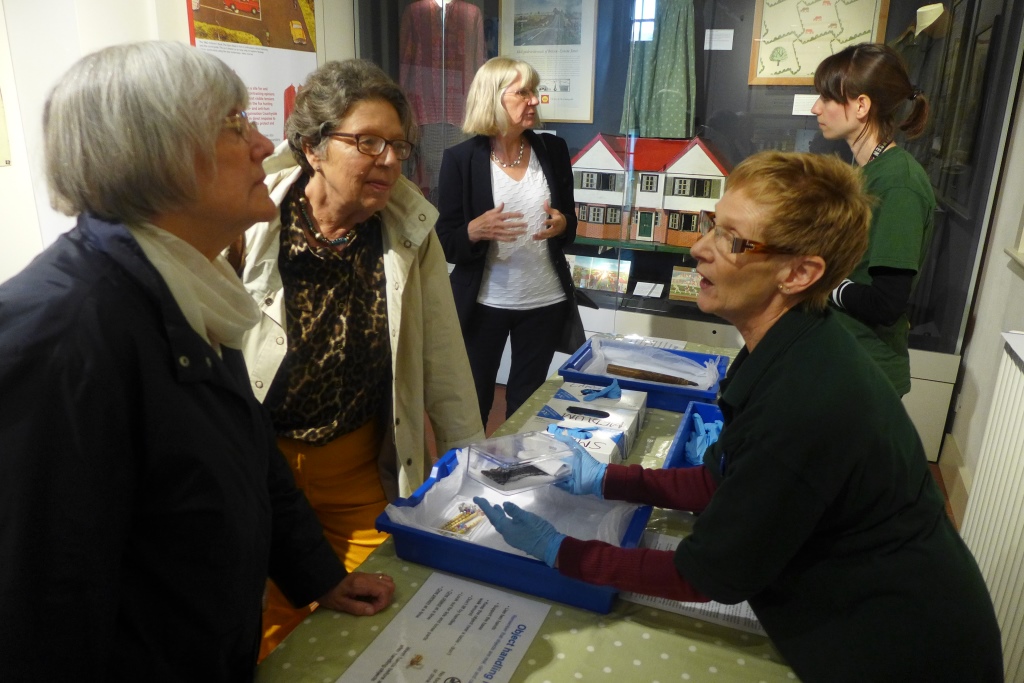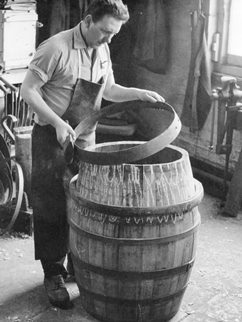As part of the Reading Engaged project, MERL is looking to develop a handling collection and programme of object handling sessions which can take place in a variety of settings: whether it be in-gallery, elsewhere on site, or off-site. We have been working with freelance curator and consultant Charlotte Dew to help us develop the collection, the sessions, and all the accompanying policies and procedures.
On Saturday we held an Information Day about Our Country Lives, MERL’s major redisplay (NB. The Museum will be closing to the public at the end of October for approximately one year, but the Library, Archives and Reading Room will remain open throughout. You can find out more about the redevelopment here) and took the opportunity to trial some of our ideas for a session based around looking at the relationship between craft tools and the finished items, i.e. how a tool is used to make something. Although we’ve been developing this session as a facilitated session for adult learners in the teaching space/studio area, we decided to test out some of the objects in an in-gallery setting.
We had four objects available for handling: two relating to lace-making, and two relating to bodging. The lace-making pair consisted of four bone bobbins (MERL 55/205/1–4) and a piece of handmade lace (MERL 59/290/8), each in a small Perspex box. The bodging pair consisted of a chisel (MERL 51/112 – we didn’t want to shy away from trying out objects perceived as ‘dangerous’ or ‘high risk’) and a turned spindle from a Windsor chair (MERL 51/63). Nitrile gloves were provided for handling this latter pair of objects.
We had a table set up in the Temporary Exhibition space, and each pair of objects was set out in a tray lined with acid-free tissue paper. We also had a copy of the ‘Object handling rules’ displayed by each tray, and boxes of nitrile gloves in small, medium and large were also set out on the table. There were two of us running the session, each taking charge of a pair of objects. I had prepared some background information for us both to look at in advance which detailed the purpose of the session, the objects we would be using, and some background information about the crafts and what sort of things we might want to discuss with visitors.
24 people (ranging from the very young to the not-so young) came up to us throughout the afternoon – and I thought this would be a good chance to critique how the session went, so here goes:
- Although everyone said they thought handling opportunities were a good idea, very few people seemed to want to pick up the objects:
- —–Were they not interested?
- —–Did they not realise they could?
- —–Was the set-up off-putting?
- —–Was the need to wear gloves off-putting?
- —–Should we have had ‘Please touch’ signs?
- More people seemed willing to pick up the lace-making objects than the bodging objects:
- —–Was this because they were in Perspex boxes so gloves weren’t required?
- —–Was this because they were smaller so you needed to pick them up for a closer look?
- —–Was this because they were somehow ‘more interesting’ objects (they were certainly more colourful)?
- —–Was this because they were more easily identifiable objects?
- The opportunity to handle real objects didn’t seem to be as important as the opportunity to discuss the objects and find out more about them on a one-to-one basis/in-depth level
- The level of background knowledge of the facilitators is really important, especially when dealing with adult audiences (and I was really glad that Jenny and I had both read up a bit on the crafts)
- Perhaps we should have asked questions that necessitated touching – e.g. feel the weight of the tool, how does the tool sit in your hand etc.
It would be great to hear your thoughts! What makes object handling appealing, and what makes it off-putting? What could we do to make it a better experience or a more successful session? Do you want to handle real museum objects?


